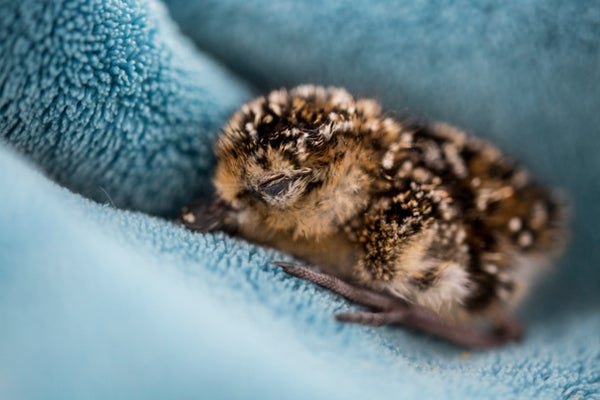This article was published in Scientific American’s former blog network and reflects the views of the author, not necessarily those of Scientific American
Could a tragedy end up helping the future of one of the world’s rarest bird species?
That’s certainly the hope right now as the Wildfowl and Wetlands Trust (WWT) conducts necropsies on two tiny spoon-billed sandpiper (Calidris pygmaea) chicks which died at their facility in Slimbridge, England, last week.
The chicks were the first spoon-billed sandpipers ever born in captivity, an incredibly important step in efforts to preserve this critically endangered species, which only numbers about 200 pairs in the wild. The species, which numbered about 5,000 birds in the 1970s, migrates more than 10,000 miles every year between the Russian Arctic and south-east Asia. Many of the wetland habitats they previously used for these migrations have been developed over the past few decades. Without those vital territories, the sandpipers’ population has crashed.
On supporting science journalism
If you're enjoying this article, consider supporting our award-winning journalism by subscribing. By purchasing a subscription you are helping to ensure the future of impactful stories about the discoveries and ideas shaping our world today.
WWT is one of many organizations trying to turn that around, or at least to preserve the species by creating what is known as a “captive assurance population”—basically an insurance policy in case the species goes extinct in the wild. A small number of wild-caught birds have lived at WWT since 2011, where the organization has used heat lamps, timers and enormous amounts of sand to try to recreate the natural conditions in which the birds could breed.
Their efforts paid off, and two female sandpipers laid a total of seven eggs in mid-June. Unfortunately, only two of those eggs hatched and the bee-sized chicks that emerged did not last long. “The first chick hatched on Saturday 2 July and it became clear quite soon that it wasn’t well and nothing could be done,” WWT said last week on its website. “The second chick hatched on Sunday 3 July and put up a brave effort; it filled everyone’s ears with lots of chirrupy noise and brought smiles to everyone as it seemed to be thriving and developing well. But despite 24 hour expert care, on the afternoon of Tuesday 5 July its health suddenly deteriorated and it slipped away within a couple of hours.”
As of this writing, the reason why the chicks did not survive remains unknown. “We won't know the cause of death until we get the results of a post-mortem exam on the chicks,” says Mark Simpson, WWT’s conservation PR manager. “We hope that the results will give some clue as to how we can improve things next time.”
The chicks’ deaths may seem like a tragedy, but Simpson says “this has still been a really positive step forward in establishing a viable breeding flock of spoon-billed sandpipers for conservation.”
Their work, he says, will continue, and each step forward will be a learning process. “Spoon-billed sandpipers don't come with an instruction manual,” Simpson says. “This is the first time in history that anyone has attempted to keep them, let alone breed them. They are unique and they have life cycle that is a challenge to recreate in captivity, so it's not easy and every advance is a small victory.”
What comes next? “The birds' breeding season comes once a year and is very short, so now we must prepare for next year,” Simpson says. “We will review everything that happened this year and take on board what we have learned. We remain optimistic that we will achieve a better result next summer, but it is a big challenge.”
Previously in Extinction Countdown:
